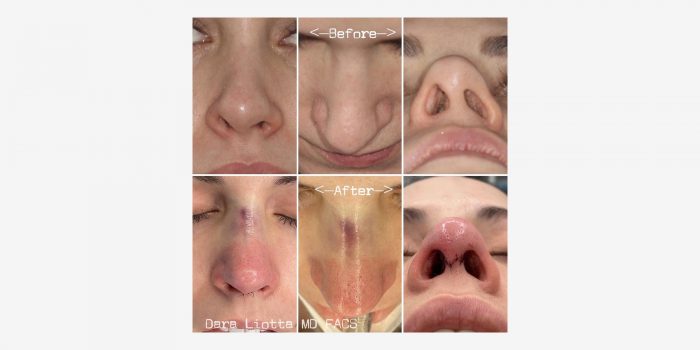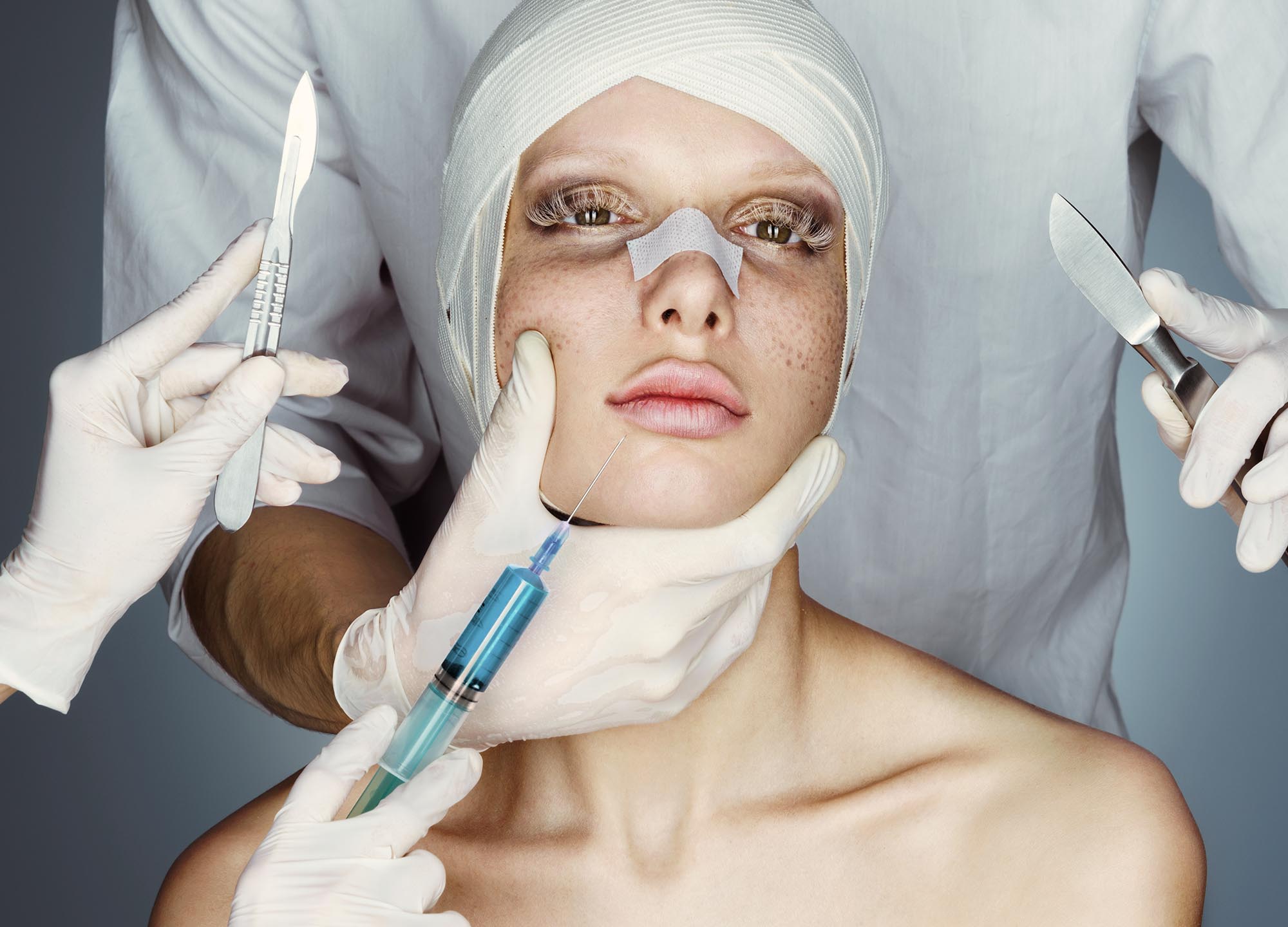We’ve written, a number of times, on the hallmarks of coveted surgical outcomes, with the goal of spotlighting key elements to look for when you’re studying doctors’ before and after photos—be it a supernatural belly button on a tummy tuck or that just-right nipple position with a breast lift. Whenever we report one of these stories, the surgeons we interview will inevitably flip the script, to approach the topic from a juicier POV—the little things that make them cringe when they see other surgeons’ work on social media or IRL.
While you might assume that the critical eye of a plastic surgeon can detect subtle blips that the average onlooker would likely miss, that’s not always the case—which is precisely why there exist classic tells, or giveaways, of popular procedures. “Even though they’re generally small features—a couple millimeters, here or there—they catch your eye passively,” explains Dr. Laxmeesh Mike Nayak, a board-certified facial plastic surgeon in Frontenac, Missouri. “You don’t have to look for them,” he adds, and even if you can’t articulate exactly what’s wrong with what you’re seeing, “you don’t have to be a surgeon to know something’s not right.”
Moreover, what makes these pieces of evidence so damning is their inherent gravity: “Even with an otherwise great result, they can mean the difference between a happy and unhappy patient, [because] they make people really self-conscious,” notes Dr. Nayak. That said, not every tell is indicative of subpar surgical skills, he points out—sometimes human tissue just behaves unpredictably. But since fixing these issues often requires a second surgery—one made more challenging by now altered anatomy and scar tissue from round one, says Dr. Tanya Khan, a board-certified oculoplastic surgeon in Austin, Texas—you really want to get it right the first time.
Ahead, the most obvious signs of nose jobs, eyelid surgery, and facelifts—2020’s top surgical procedures, according to the American Society of Plastic Surgeons annual trends report—and how surgeons aim to avoid them.
Facelift fails
“You only see the bad work” is a common refrain among plastic surgeons—and applies perfectly to facelifts. The powerful procedure tackles loose skin and droopy jowls, restoring youthful contours, for a naturally refreshed look—but it’s no small surgery, and hiccups can happen.
Poorly placed incisions
For virtually every surgical procedure, conspicuous scars are an obvious tell. With facelifts, concealment involves an added degree of difficulty, because scars—especially long, winding ones—can’t easily blend in on the face.
Traditional facelift incisions generally start in the hairline, at the temple, and travel around the ear before terminating in the lower scalp. “All incision lines heal into a white or fair line, so we try to nestle them in highlights and shadows,” Dr. Nayak explains. “The ear has all kinds of reflections on it from its sharp bends and contours, and if we place our incisions in the right spot, that fair section passes as a reflection.” If cuts are not strategically positioned—or if scars drift forward months to years later, as can happen with a too-tight facelift—even the finest, flattest line will read as a glaring sign of surgery.
Missing sideburns
Sometimes attempting to keep incisions off the face can disturb the hairline. When slicing into the temple area, if the sideburns—which, even in women, are an important landmark—get lifted along with the face and trimmed away, says Dr. Nayak, “you could end up with a big hairless patch of cheek in front of the top of your ear, which makes your hair almost look like a Lego cap, set on top of your head as opposed to being part of the frame of the face.”
Misshapen ears
Once a surgeon elevates and repositions the deeper tissues of the face and addresses any excess, they should close with the skin in utter repose. “Facial skin is not built to hold tension,” Dr. Nayak tells us. “It can be tempting to get a little more effect by pulling on the skin when you close, but it’ll inevitably stretch and relax back out.”
And when an overly taut facelift gradually gives way, not only can scars widen and drift, but the ears can get contorted. “If there’s too much tension on the wound or too much skin resected [cut away] around that area, the scar can contract over time, pulling the tragus forward,” says Dr. Catherine Chang, a board-certified plastic surgeon in Beverly Hills, California. The tragus is a tab of cartilage in front of the ear that helps to obscure the ear canal. When the tragus shifts, adds Dr. Nayak, it exposes that hole in the head while also losing certain identifying characteristics. “There should be a little bright convexity on the tragus itself and a dark concavity just in front of it,” he says. “Without that hill-and-valley feature, it looks a bit odd.”
Tension is also to blame for the so-called pixie ear deformity that can occur following facelifts. And unfortunately, the cute name belies its appearance: “The earlobe is pulled downward and looks tethered and stretched,” Dr. Chang explains.
Windswept effect
There is perhaps no bigger facelift deterrent than the fear of looking startlingly pulled. While the wind-tunnel effect is largely a by-product of outdated techniques, certain aspects of it can still be seen today—namely, oddly oriented wrinkles. “Wrinkles normally tend to echo out, like parentheses,” says Dr. Nayak, “but if we lift in an awkward direction or with skin tension, they can end up turning into more of a swoosh shape, like a lazy S on its side.” So while modern surgeons generally like to hoist the deeper tissues of the face in a vertical direction, when it comes to the skin itself, “the more sun-damaged it is, the more straight horizontal it needs to go,” Dr. Nayak says, to avoid that awkward sweep of any wrinkles that remain post-lift.
Blepharoplasty fails
“When it comes to the eyes, good work should be pretty much undetectable,” Dr. Khan says. The common tells of lid lifts are typically born of errors in judgement.
Misplaced crease incisions
On the upper eyelids, “we have the beauty of hiding the scar within the natural crease,” says Dr. Khan. When surgeons miss the mark, however, and place an incision too high, it can change the shape of the eyelid—and “that’s the kind of thing that can give people [an] identity crisis,” notes Dr. Nayak. The lid platform—that strip of skin where we might apply eyeshadow—is important to preserve, he adds. When someone goes from having only a fragment of skin there to a wide expanse, “they often don’t recognize themselves.”
Ill-fitting lower lids
According to Dr. Khan, surgeons typically try their best not to remove skin from the lower eyelid when performing blepharoplasty. “The major anatomical issue there is prolapsing of the fat pads—the fat is pushing forward, and that’s what needs to be removed,” she says. In most people, once the bulging fat is addressed, the skin will contract on its own. If it doesn’t, “we may do a little tightening in the corner, like a lateral canthopexy or canthoplasty, where we pull the tendon and muscle just a tiny bit, to help drape the skin across the lid better.” She may also use lasers in conjunction with surgery, to “tighten the skin down without taking any out,” she adds.
These more conservative moves ensure that the lower lid doesn’t end up uncomfortably taut or ride too low on the eyeball and the patient doesn’t struggle to close their eyes fully after surgery, Dr. Khan explains. If too much skin is removed and even a sliver of eyeball is left exposed, all kinds of problems can arise, ranging from chronic irritation to uncontrollable tearing. Aesthetically speaking, changing the position of the lower lid by even a millimeter or two can dramatically alter the shape of the eyes, adds Dr. Nayak, making it clear you’ve had work done.
Rhinoplasty fails
“Noses are ridiculously complicated,” says Dr. Dara Liotta, a board-certified facial plastic surgeon in New York City. A number of things can go awry during a rhinoplasty—excessive whittling is often to blame—and missteps are hard to hide.
Bridge abnormalities
One classic complication, the inverted-V deformity, reads as an upside-down-V-shaped shadow across the dorsum, or bridge of the nose, which is made up of both bone and cartilage. “This [issue] is caused by a visible step-off from the nasal bones to the cartilage, and usually results after a bump is removed and the cartilage is not supported,” Dr. Liotta says. “The way to prevent it during surgery is with spreader grafts, which are strips of cartilage used to support the cartilage and keep the bridge smooth and regular.” The grafts can be harvested from the patient’s septum or rib or from a cadaveric rib, notes Dr. Chang.
If a surgeon files down the dorsum too much, the nose can look scooped-out on profile, giving it a ski-slope vibe. Unlike most of the tells we’ve been talking about, this one can sometimes be improved nonsurgically, with filler. The nose is a notorious danger zone for injections—particularly after it’s been operated on—so seek out a rhino specialist for this fix.

Tip troubles
“Pollybeak deformity” or “supratip deformity” are terms given to a post-op nose that’s reminiscent of a parrot’s beak, doctors say, with an unnatural fullness just north of the tip (the area known as the supratip), which causes the tip itself to droop downwards. “It can result from not removing enough cartilage above the tip of the nose, from scarring [inside the nose], or from the tip of the nose falling because it’s not supported properly,” explains Dr. Liotta.
The tip of the nose can succumb to other pitfalls too, like overrotation—surgeon-speak for an upturned nose—which can occur when a surgeon aims to lift a droopy tip but inadvertently shaves away too much of the septum or other tip cartilages, effectively shortening the length of the nose and causing the nostrils to face forward more than they should. (We should note that a slight upturn of the nose immediately after surgery is normal—tips typically settle as swelling subsides over the course of several months.)
A “twisted tip,” which Dr. Chang describes as “rotated due to a serpentine septum or uneven lower lateral cartilages,” can also be a giveaway of rhinoplasty—though not always, she adds, since certain people actually display shades of this preoperatively. In those patients, notes Dr. Liotta, “rhinoplasty can exaggerate asymmetries that are preexisting, if they’re not noted and proactively corrected during surgery.” Generally speaking, she adds, surgeons can keep a tip from twisting by fixing a deviated septum and any apparent asymmetries and “adding support in the form of sutures and grafting.”
Retracted nostrils
When the cartilages comprising the tip of the nose retract, or pull up and back, after an aggressive sculpting, the outer rim of the nostrils appear oddly elevated, says Dr. Chang, revealing too much of the inside of the nose. According to Dr. Liotta, this complication “can be prevented by conservative trimming of this cartilage or with the placement of certain grafts, like batten grafts or rim grafts, in patients who are prone to this issue during healing.” She’s quick to add that “knowing who needs which grafts is complicated and based on experience [from] doing thousands of rhinoplasties and revision rhinoplasties.”











